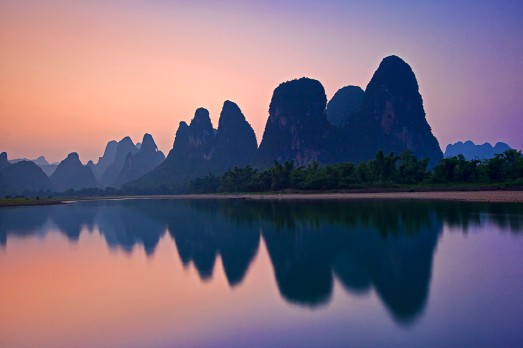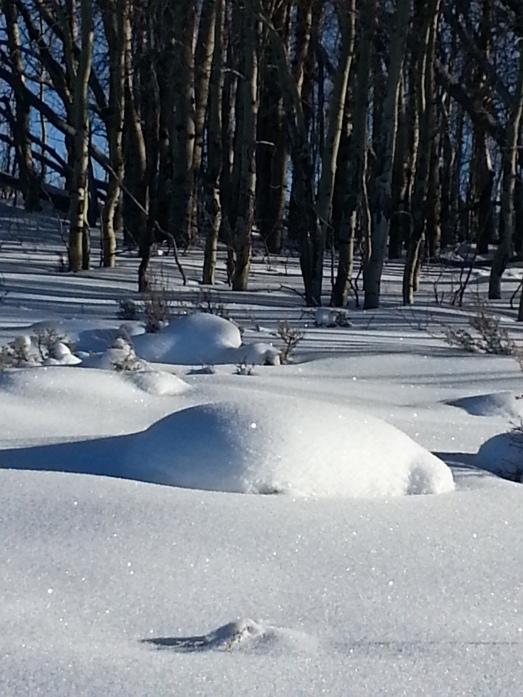Tree anthropologists everywhere have wet dreams about this kind of luck. Last weekend I received a coveted invitation to visit a little known tree community in the White Clouds mountain range of central Idaho and, needless to say, jumped at the chance. The day was a perfect storm of ideal conditions…calm weather, crystal clear skies, total solitude, and unprecedented access. The following is the photo/documentary report I’ve submitted to The Boston Journal Of Arborealogy.
My primary focus as a tree anthropologist has been the study of funereal practices among high altitude trees of the North American mountain west and while, admittedly, most of the tall timber rites I’ve observed wouldn’t translate well for human adoption, there are a few elements that might help inform our primarily human-centric views on death and dying.
ARBOREAL RESPECT FOR THE DEAD
The first and most obvious difference between tree and human treatment of the dead is that trees make no effort whatsoever to hide theirs. It’s truly striking. For instance take a look at this photo of a recently deceased elder who clearly held great stature among the local community.

Even more surprising is the fact that, during the rapid years of its pine beetle fueled decline, this giant was apparently not only allowed but encouraged to display that, too, for the entire community. (Note the willow shrubs and young Ponderosa pines posted to stand guard in the foreground…one of the many indicators that this tree was highly regarded in life and remains so in death. Immediately below is a photo of another highly regarded dead tree with posted willow shrub guards. Note the surviving spouse standing alongside in this example.)

INTERMARRIAGE
Next, I was given a brief introduction to the following “Jack Spratt could eat no fat, His wife could eat no lean” looking couple but was not allowed to ask questions. I believe the loss was still fresh. Jack’s wife seemed to be fairly distraught, entangling her lower branches with his now bare and drooping ones.

Evidently, there’s some sensitivity surrounding the fact that this was an interspecies marriage but I couldn’t put my finger on exactly why. While intermarriage between a variety of evergreen species is widely accepted, intermarriage between evergreens and deciduous species is less so. (Obviously this places Aspen, as the only deciduous trees in the area, at a decided disadvantage.) I couldn’t discern whether this taboo arises from the lack of any possibility for cross pollination or from the wide difference in life expectancies. Individual Aspen don’t live nearly as long as, for instance, Douglas Fir or Lodgepole Pine, so the tragic outcome displayed above is inevitable.
ARBOREAL PLAY
Moving on. As an interesting and little known aside, I wanted to mention that trees can also be surprisingly playful. When the ones in the picture below saw me angling for a photograph of the mountain range behind them, they began mischievously crowding together to block the shot in a well-known tree version of the game “Peek-a-boo.”

At first it was just irritating, but that was before I noticed the unconscious, aesthetic instinct that appears to be common among high altitude trees. I was amazed to discover that no matter how they blocked the view, this little gang o’ green left just enough of the mountain range exposed behind them to reveal a scene of subtle but unmistakable beauty and, once I let go of my preconceived notions of the shot, we had a lot of fun. Trees are natural hams and will usually hold a pose for as long as you need. Here’s another group of adolescents playing the same game:
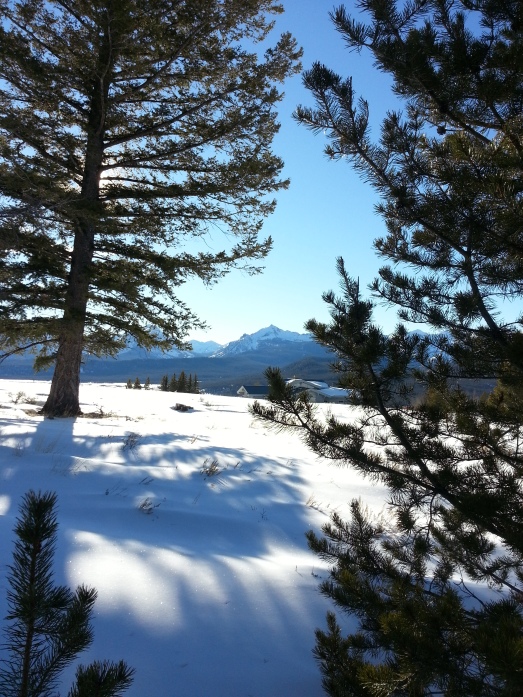
It’s a strange fact that even dead trees sometimes enjoy a good game of “Peek-a-boo”, only their ability to effectively block whatever’s behind them is understandably compromised. I’m happy to announce however, that their innate aesthetic sense is not. Please note the two examples below:


I was amused to find some of the native shrubs in the area attempting to mimic the game, but of course they lack the necessary height for effective play. Thus, I finally managed to capture the original mountain photograph I was after here:

ARBOREAL PARENTING AND PROGENY
High altitude trees of the mountain west are widely recognized as devoted parents and the ones in this region are no different. Here’s a photo of one of their young taken while visiting a community daycare center.

Tree youth are granted considerably more freedom than their human counterparts, largely because saplings are more sedentary. Not that the dangers they face are any less, but at least they can’t wander off looking for trouble.
Tree seeds, on the other hand, are wildly mobile. Seedhood is well known as the most unpredictable phase of all tree life, with the popular-but-dangerous game “Grow Where You Fall” observed worldwide and across most tree species. Every mature, seed-bearing tree in this region has grisly stories to tell of tiny seeds leaping from their branches to be swept away by wind gusts, and indeed the infant mortality rate among emerging seedlings is upwards of 99%.
Staggering, I know. How tree parents bear those kinds of losses is beyond me. Perhaps it’s their longer perspective, the same thing that anchors and steadies them through the cyclic punishment of winter storms and icy nights. I often wonder if their epic suffering is what ultimately helps them exude the sense of serenity that mountain trees are so famous for. There’s no way to know of course, but I myself have learned a great deal about endurance by hanging around under their branches.
THE “SHORT DEATH”
Unlike humans, trees experience both what is known as a “short” death and a “long death.” Short death is actually just a hibernation of sorts and can be triggered by failing light, winter cold, or drought. It’s most familiar display happens among deciduous trees whom, at the first sign of winter, drop all their leaves and fall asleep where they stand in a kind of narcoleptic response to the stress.
Needless to say leaves everywhere hate the practice and in some regions have attempted to unionize to prevent it, but so far without success. The unfortunate little fellow pictured below managed to cling to his twig longer than most but I’m afraid February finally claimed even him.

ASPEN
Now…throwing all scientific objectivity aside for a moment…I must say I found the Aspen in the area to be a delight beyond anything even I had hoped for. As a succession species their position in the larger community is not enviable, and yet somehow, despite widespread marginalization, they still maintain a childlike openness. Like everyone else, I was raised on charming tales of the mysterious attraction Aspen trees so often display for humans but still, the actual experience of having a circle of these white-barked beauties gather to peer down at me in unabashed curiosity was a thrill I will never forget.


ASPEN “PEEK-A-BOO”
Of course Aspen love to play “Peek-a-boo” as much as other species, but they’ve learned how to model a unique, winter “slow death” style that’s become quite a draw for photographers. I’ve included two of my own modest examples below:


But if you want to see a couple of spectacular photographs that draw from the lesser known but even more beautiful “Block the Peek Completely” style, try here and here.
A RARE LACK OF INHIBITION
While Aspen are universally friendly, individually they’re quite shy preferring to cluster in groups. This is due in large part to the fact that each copse, however large, shares a single root system. However, you can still occasionally find a rare exhibitionist such as the nubile example below:

Breathtaking.
SOME PHENOMENA RARELY CAPTURED ON FILM
The existence of animales non evidens (or Invisible Ones) is a subject hotly debated among arborealogists and not likely to be settled anytime soon. Much like Big Foot and the Spanish chupacabra, most reports originate from sightings of their tracks, but unlike their larger counterparts, animales non evidens themselves are truly indiscernible to the naked eye. In addition, their tracks can only be seen in winter as their body mass is apparently too insubstantial to imprint on anything heavier than snow, making them that much harder to detect.
High altitude tree communities universally report a close and symbiotic relationship with non evidens and in fact assign them an almost revered status. Indeed, Invisible Ones are said to play an important role in all arboreal funeral rites as they are essential to the slow decomposition process that breaks down a dead tree to its original elements…a final state that is the closest approximation trees have to an afterlife. I was assured by several of the Aspen I spoke with that the tiny tracks in the photograph below were indeed left by non evidens. I submit them here for review and discussion.

I was understandably excited by the find and immediately commenced a search for more tracks. At first I thought I’d hit the jackpot when I discovered those shown below, but the Aspen just chuckled and told me they were from a rabbit.

Unlike human grieving, the stage of arboreal death where loss is experienced most keenly is not when a tree initially dies, but when its desiccated trunk finally falls to the ground. In a forest situation it’s not uncommon for surrounding trees to actually catch a swaying companion in their branches and hold them there for months…sometimes years…before allowing their final collapse.
This practice is called suspension and is particularly important to high altitude Aspen since 1) they invariably grow in close copses and 2) they’re subject to such a brief lifespan. There’s an esoteric but widely held belief in this region that suspension somehow extends an Aspen’s life and indeed, it’s considered a “bad death” if any tree makes its final fall without the lingering support of community. One copse of Aspen allowed me to take the photo below and I cannot overstate the generosity of their permission. As you can see, these trees were devastated by grief, the two on the left even going so far as to experience a “sympathy death.”
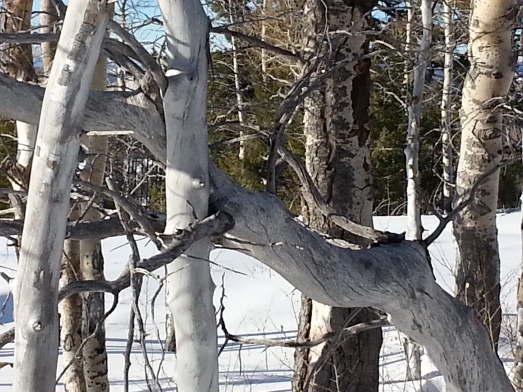
ARBOREAL BELIEF SYSTEMS
The spiritual meaning that high altitude trees assign to dying and death are notoriously difficult to translate but perhaps the easiest explanation is that death is regarded more in the light of an act of generosity than in the human sense of tragic loss. I suspect much of this comes from the paucity of local resources and the corresponding limit to the number of trees the region can support.
Seen in this context the death of a tree holds a double gift: Not only does it free up the resources it would otherwise consume, but it also eventually contributes the nutrients contained in its own structure back to the surrounding community through slow composting. For this reason dying is considered to be an honored…even sacred…act, which is perhaps why they make no effort to disguise or hide it.
All the trees I spoke with seemed confused by the human concepts of “God” and “heaven,” primarily because they can’t seem to distinguish between “this” and “other” worlds. However, there is a transcendental element to their beliefs. They actually have three words for “life” (all of which are lovely, melodious sounds made by wind moving through leaves or needles.)
1) The first word roughly translates to mean biological life.
2) The second is closer to the human idea of energy, while
3) The third simply has no equivalent. Trees describe it as a sound they can all make…even dead trees…in response to a feeling of supreme content. It’s inaudible to the human ear but is often felt on a tactile level, like the rumbling of a distant waterfall, or the ground vibration of a running herd, or the distant growl of an airliner flying at 30,000 feet. Predictably, the larger the tree, the stronger the sound/vibration they emit.
When humans do report an experience of this arboreal call, it’s usually described in terms of beauty rather than sound. Who hasn’t seen a person standing and staring, bemused and mouth agape, at some spreading tree specimen the beauty of which temporarily incapacitates them? Indeed, I’ve occasionally seen entire groups held spellbound by the same effect. (Nature photographers seem to be particularly susceptible.)
Older reports all indicate that the sound deepens when emanating from a dead tree…magnified a hundred fold in fact…but, while I’ve often longed to hear it myself, the opportunity to do so is almost nonexistent in areas where human and tree communities overlap. This is due to the human custom of immediately cutting down any tree that appears to be dying or dead.
However, I’m delighted to announce I finally heard it on this trip. Twice no less.
It was nearing sunset and I was preparing to take my leave, offering the many slow and formal farewells that are such an integral part of arboreal etiquette. It was during the last round of “boughing” (a kind of upper limb waving that frankly, looks ridiculous on a human being, but is pure ballet when performed by a tree) that I felt the first sound begin to resonate in my chest. It happened while “boughing” to the cluster pictured below:

I have to say, I now understand on a visceral level why trees regard the sound with the reverence they do. It’s moving, heartbreaking, and deeply disorienting…suggestive of something ancient and vast…and in a strange way it really does evoke an unusually strong impression of life itself, even though it’s emanating from something that has died. Indeed, the overall effect was one of sensory awareness heightened to an almost ecstatic degree, like the best imaginable blend of heartfelt prayer, smooth opiates, and skinny dipping.
I finally managed to reorient myself with some effort and took my leave, retracing my tracks on the long trudge home.

The second sound came as I was nearing the top of a ridge and looked up to find this magnificent dead elder standing sentinel there:

There followed an undetermined lapse of time where I was held, frozen and slack jawed, by the unearthly sound it generated (evidently in response to the coming sunset. Trees and sunsets share a long, almost legendary history widely chronicled in their mythologies.) Fortunately, I was finally recalled to myself by the increasing cold and I managed to salvage enough presence of mind to get this one, rare shot before the sun disappeared and the light was entirely lost.
The whole experience was extraordinary, even more so because the vibration continued resonating in my chest for a long time after the original sound itself had faded. It lasted the entire time it took me to retrace my steps back to the cabin and only ended completely once I stepped inside and closed the door.
The next event I’m scheduled to attend is The Rocky Mountain Clonal Conference (hosted jointly by the Utah Quaking Aspens and Snake River Shrub Sumacs) followed by The Prometheus Scholarship Awards (named for the famous 5,000 year old Bristlecone Pine cut down by a U.S. Forest Service Service graduate in 1964.) These scholarships are given out every hundred years or so to the most promising crop of young saplings collecting folklore and songs from our oldest surviving trees. I will of course only be able to attend the opening ceremony as the entire conference lasts about seventeen years.
And lastly, for any readers who actually made it all the way to the end of this silly, fantastical report…you, too, are hereby awarded an honorary Prometheus Award for your extravagant disregard as to the value of human time. Bravo. (You have permission to download the following logo and display it prominently on any blog, website, or letterhead you choose.)

copyright (especially the award) Dia Osborn 2013







 There’s a long, south facing hillside up in the Stanley valley, near Redfish Lake, which is covered with an equally long stand of aspen trees. There’s a trail that meanders along the base of the hillside for a few miles and I’ve always thought that hike would be spectacular in fall when the trees were in full color but for two decades I’ve missed it. Successful leaf peeping requires timing, luck, and motivation and for whatever reason I’ve never had all three in sync.
There’s a long, south facing hillside up in the Stanley valley, near Redfish Lake, which is covered with an equally long stand of aspen trees. There’s a trail that meanders along the base of the hillside for a few miles and I’ve always thought that hike would be spectacular in fall when the trees were in full color but for two decades I’ve missed it. Successful leaf peeping requires timing, luck, and motivation and for whatever reason I’ve never had all three in sync. Above is Fishhook Creek running through a large beaver engineered water system that spans the meadow with a couple of Sawtooth peaks behind.
Above is Fishhook Creek running through a large beaver engineered water system that spans the meadow with a couple of Sawtooth peaks behind. Foothills in front of the White Clouds mountain range during sunset. You can see pockets of color as the aspen are changing.
Foothills in front of the White Clouds mountain range during sunset. You can see pockets of color as the aspen are changing. This is a stone in Fishhook Creek full of iron, which gives it the orange-red color. (It’s an iron rich area.)
This is a stone in Fishhook Creek full of iron, which gives it the orange-red color. (It’s an iron rich area.) This is a view of part of that long hillside I mentioned. The color just keeps going and going and going and going…
This is a view of part of that long hillside I mentioned. The color just keeps going and going and going and going…


 Sunlight illuminating the leaves from behind. The photo doesn’t do it justice of course. The real effect was rather holy…another one of those moments out in the natural world when the impulse to fall on my knees and whisper thank you to whatever would listen almost got me. In the end I couldn’t do it in front of the Canadian hikers behind me but still, we were all pretty quiet and big eyed.
Sunlight illuminating the leaves from behind. The photo doesn’t do it justice of course. The real effect was rather holy…another one of those moments out in the natural world when the impulse to fall on my knees and whisper thank you to whatever would listen almost got me. In the end I couldn’t do it in front of the Canadian hikers behind me but still, we were all pretty quiet and big eyed.


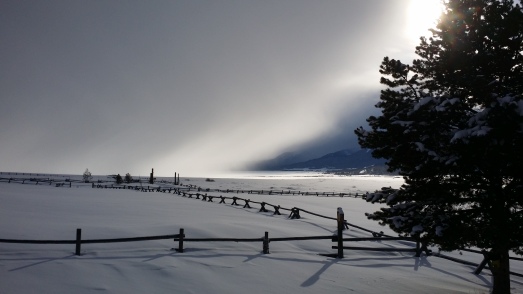 Tired yet? But I have so many more. Sigh.
Tired yet? But I have so many more. Sigh. And the last is…well, we have no idea what this is. It’s a phenomenon we’ve only ever seen up at the cabin this once. It was a column of light that shot up unexpectedly from the setting sun. It was HUGE. The photo doesn’t capture that part. And most odd, lasting about two minutes from the time we first saw it.
And the last is…well, we have no idea what this is. It’s a phenomenon we’ve only ever seen up at the cabin this once. It was a column of light that shot up unexpectedly from the setting sun. It was HUGE. The photo doesn’t capture that part. And most odd, lasting about two minutes from the time we first saw it. Sorry for the enormous size of the photograph. WordPress changed the download media feature while I was gone and I haven’t figured out how to resize yet. As mentioned…dilettante.
Sorry for the enormous size of the photograph. WordPress changed the download media feature while I was gone and I haven’t figured out how to resize yet. As mentioned…dilettante. 




























